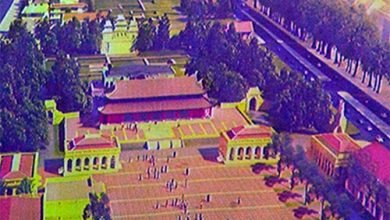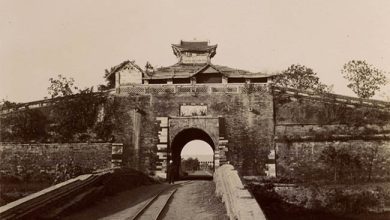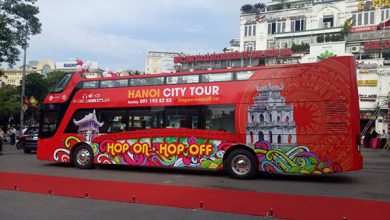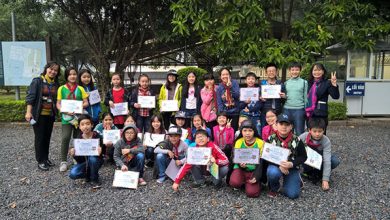Lý Thái Tổ – the brain son of Buddhism, the founding father of Thăng Long
On the morning of 18/4/2018, at Kính Thiên Palace Foundation of Thăng Long Imperial Citadel, The Thăng Long – Hà Nội Heritage Conservation Centre held an incense offering ceremony to commemorate the 990th anniversary of the decease of King Lý Thái Tổ, the first king of the Lý Dynasty (1028- 2018).
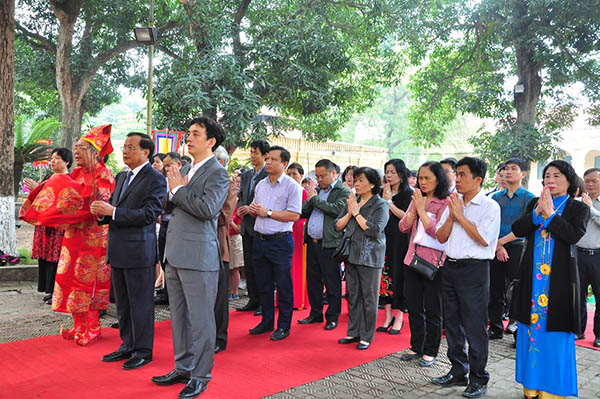
Participants and visitors paying tribute to King Lý Thái Tổ.
King Lý Thái Tổ, known by birth as là Lý Công Uẩn, was born in 974. According to inscriptions on stele titled “Hoa Lâm Tam Bảo Thị”, whose complete rubbing coded 2985/2986 is now preserved at the Institute for Sino-Nôm Studies, Hoa Lâm was the renowned hometown of Lý Công Uẩn’s paternal grandparents. His parents’ tombs were also located here. Stele inscribers and the elderly of hamlets and communes of Đình Bảng, Dương Lôi, Tam Sơn, Tam Tảo, Tiêu Sơn Thượng, Tiêu Long who contributed to the restoration of the Tiêu Pagoda at that time all concurred that Hoa Lâm Commune of Đông Anh District in Đông Ngàn was the natal home village of Lady Phạm, Lý Công Uẩn’s mother, now Du Nội Hamlet, Mai Lâm Commune, adjacent to Đông Hội, Đông Anh District, Hà Nội. This is confirmed not only through the poems of Nguyễn Phi Khanh, parallel couplets of Nguyễn Tư Giản who despite their adopted family name of Nguyễn were descendents of the Lý origin and through the memory of elderly closely attached to the homeland, but also through rare and precious stelae that date back more than three centuries ago. His mother was a lady known by the name of Phạm Thị (Ngà), who gave Lý Công Uẩn to Monk Lý Khánh Vân of Dâu Pagoda Pháp Vân) as an adopted son. When he was 7, Lý Công Uẩn was sent by his adoptive father to study under the tutelage of Monk Vạn Hạnh of Lục Tổ Pagoda (also known as Tiêu Sơn) in Tiên Du District of Bắc Ninh.
With inborn intelligence and learning avidity nurtured through meditation, Lý Công Uẩn was taught by Zen Master Vạn Hạnh both literature and martial arts as well as a spirit of nobility at a time when the country had only recently regained its independence and sovereignty after 1000 years of Chinese occupation and was in great need of peace for national development and popular prosperity. It was these factors that nurtured in the young man of the Lý family a love for the people and the country.
In his early manhood, Lý Công Uẩn was recommended by Zen Master Vạn Hạnh to serve in the Hoa Lư royal court under the reign of Lê Đại Hành. He assumed the post of commander of imperial guards until the reign of Lê Long Đĩnh (1005-1009).
After the decease of King Lê Long Đĩnh in 1009, he was supported by military and civil court officials as well as Monks Khuông Việt and Vạn Hạnh to become Emperor, with a new dynastic title of Thuận Thiên the first year (1009), and a capital city placed in Hoa Lư.
With a strategic vision that embraced geomantic, cultural, societal, economic and military conditions, King Lý Thái Tổ after 10 months of enthronement decided to move the capital city to Đại La in the eighth lunar month of 1010.
After seeing golden dragon soared into the sky when his royal boat docked the Red River, the King decided to rename Đại La as Thăng Long (literally Ascending Dragon, now Hà Nội).
After positioning the capital city in Thăng Long, the king ordered the planning and construction of Thăng Long Imperial Citadel with Càn Nguyên Palace as the court meeting place where the king and his mandarins discussed national affairs. He also renamed the former capital city Hoa Lư as Tràng An regional capital, natal home village of Cổ Pháp as Thiên Đức (in today’s Bắc Ninh). Many other edifices were also constructed to turn Thăng Long into a worthy eternal capital city of Vietnam, a country of a thousand-year civilization.
Besides, on many occasions, the King also issued edicts about the construction of pagodas within and beyond Thăng Long and in his natal home village of Cổ Pháp, such as Hưng Thiện, Đại Giác, Thiên Quang, Thiên Đức, Thiên, Hưng Long, Thắng Thọ, Phúc Lâm in Hoa Lâm Viên, etc.
In 1024, Chân Giáo Pagoda was built inside the citadel so that the King could come to pray and conduct rituals as well as invite Buddhist monks to preach scriptures to the court officials and the populace.
In 1027, Tripitaka (Tam Tạng Kinh) was produced in multiple copies to be disseminated to the research circle who studied at Bát Giác, Đại Hưng and other key pagodas inside Thăng Long Imperial Citadel.
He considered the Buddhist teachings as the fundamental moral basis, extracted the teachings of Buddha in §¹i T¹ng kinh and the maxims, adages, preachings of the Zen masters. The pagoda at that time served dual purpose of the place to train humans in general and a school to educate moral and talented people, such as T« HiÕn Thµnh, Ng« Hoµ NghÜa, Lý Thêng KiÖt, L¬ng NhiÖm V¨n, NguyÔn §¹o Thµnh. Espcially noteworthy was the fact that under the reign of Lý Nh©n T«ng, the Royal Academy (Quèc Tö Gi¸m) was established in 1076, known popularly as the first university of Vietnam, while Vesak was conducted and Yulan (Ghost Festival) orgnanized in 1072; the Qu¶ng ChiÕu Lantern Festivals was held in 1110, 1116, 1120, 1128 under the reign of Lý Nh©n T«ng and others. Thanks to an education system which was characterized by humanity, mercy, tolerance and intelligence, the population background was elevated, creating a basis for every Buddhist academic and architectural work of the Lý Dynasty to be continued into the TrÇn Dynasty (1225 – 1400).
Military strategy was reinforced and developed. The army, powerful and seasoned, emerged as victors against the invasion of the Chinse Song Dynasty. It was during the Lý dynasty that the territory of Viet Nam was expanded.
In terms of social life, the people lived in prosperity and abundance with a country known for its progressiveness, to the extent that the Song dynasty envoy had these commending descriptions: “(Vietnam) was a propserous and happy society where the population had stability of job and lodgement, freedom from natural disasters, rich and fertile soil and contiuned to be developed and expanded”.
With mercy, benevolence, tolerance and forgiveness at its core, supported by the ideals of other two religions in the trio, Buddhism served as the overall orientation for the development of the country, aided by pious kings, mandarins and populace. Buddhism under the Lý dynasty created a homogenous, moral, goodwill-oriented, stable and peaceful society that was unmatched in the history of the nation and the religion itself.
After successive dynasties of Lý, TrÇn, early Lª, T©y S¬n, NguyÔn, over to the era of Hå ChÝ Minh, Th¨ng Long – Hµ Néi continued to serve as a convergence and divergence of natinoal vitality brought about by ancestral kings and forefathers who were of great meritorious service to the country as well as to Vietnamese Buddhism. It is also a national cultural hub which has enjoyed rapid and continous development, preserving the cultural identities of the nation and the glorious spirit of the national history. The city of Ascending Dragon with Red River emptying into the East Sea has fostered solidarity with counterparts worldwide especially in an increasingly globalized world. “Expanders of the country recalled and reminisced the land of Th¨ng Long ” goes a poetic line by Huỳnh Văn Nghệ.
Some photos at the incense offering cereomon:
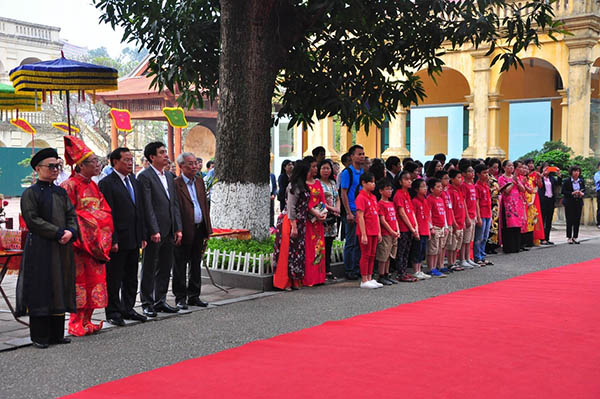
The incense offering ceremony solemnly held at the Dragon Steps of Kính Thiên.
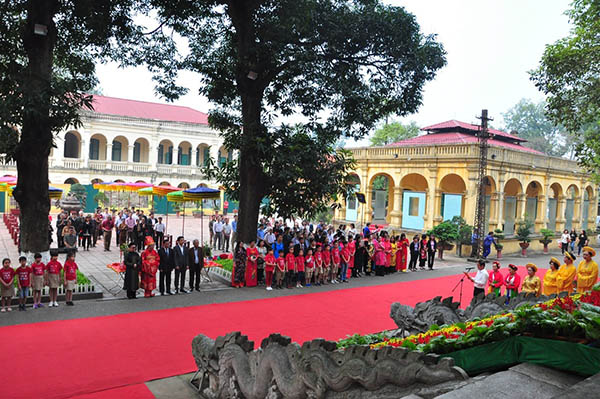
Teachers and schoolchildren of the Lý Thái Tổ Primary School paying tribute to the king who founded Thăng Long and built the Great Việt state.

Overview of the incense offering ceremony.
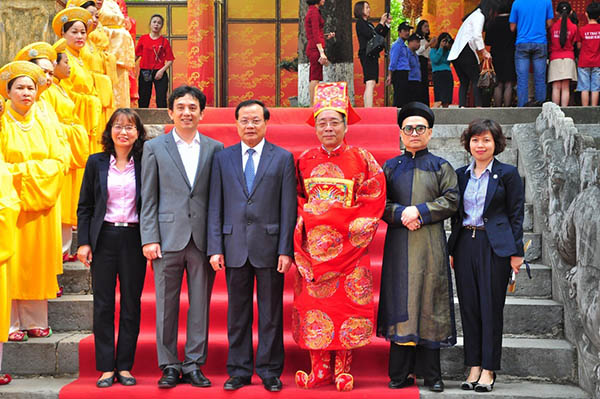
Mr. Phạm Quang Nghị – former Secretary of Hà Nội Party Committee taking a photo in front of the Dragon Steps at Kính Thiên Palace Foundation.
Text collected by: Trường Lương
Photos by: Quốc Dũng

